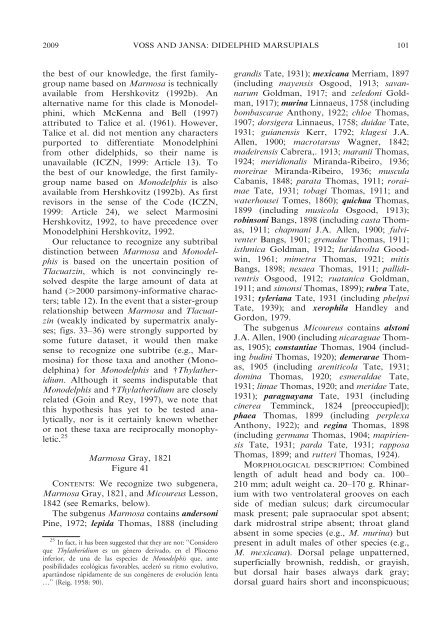phylogenetic relationships and classification of didelphid marsupials ...
phylogenetic relationships and classification of didelphid marsupials ...
phylogenetic relationships and classification of didelphid marsupials ...
You also want an ePaper? Increase the reach of your titles
YUMPU automatically turns print PDFs into web optimized ePapers that Google loves.
2009 VOSS AND JANSA: DIDELPHID MARSUPIALS 101<br />
the best <strong>of</strong> our knowledge, the first familygroup<br />
name based on Marmosa is technically<br />
available from Hershkovitz (1992b). An<br />
alternative name for this clade is Monodelphini,<br />
which McKenna <strong>and</strong> Bell (1997)<br />
attributed to Talice et al. (1961). However,<br />
Talice et al. did not mention any characters<br />
purported to differentiate Monodelphini<br />
from other <strong>didelphid</strong>s, so their name is<br />
unavailable (ICZN, 1999: Article 13). To<br />
the best <strong>of</strong> our knowledge, the first familygroup<br />
name based on Monodelphis is also<br />
available from Hershkovitz (1992b). As first<br />
revisors in the sense <strong>of</strong> the Code (ICZN,<br />
1999: Article 24), we select Marmosini<br />
Hershkovitz, 1992, to have precedence over<br />
Monodelphini Hershkovitz, 1992.<br />
Our reluctance to recognize any subtribal<br />
distinction between Marmosa <strong>and</strong> Monodelphis<br />
is based on the uncertain position <strong>of</strong><br />
Tlacuatzin, which is not convincingly resolved<br />
despite the large amount <strong>of</strong> data at<br />
h<strong>and</strong> (.2000 parsimony-informative characters;<br />
table 12). In the event that a sister-group<br />
relationship between Marmosa <strong>and</strong> Tlacuatzin<br />
(weakly indicated by supermatrix analyses;<br />
figs. 33–36) were strongly supported by<br />
some future dataset, it would then make<br />
sense to recognize one subtribe (e.g., Marmosina)<br />
for those taxa <strong>and</strong> another (Monodelphina)<br />
for Monodelphis <strong>and</strong> {Thylatheridium.<br />
Although it seems indisputable that<br />
Monodelphis <strong>and</strong> {Thylatheridium are closely<br />
related (Goin <strong>and</strong> Rey, 1997), we note that<br />
this hypothesis has yet to be tested analytically,<br />
nor is it certainly known whether<br />
or not these taxa are reciprocally monophyletic.<br />
25<br />
Marmosa Gray, 1821<br />
Figure 41<br />
CONTENTS: We recognize two subgenera,<br />
Marmosa Gray, 1821, <strong>and</strong> Micoureus Lesson,<br />
1842 (see Remarks, below).<br />
The subgenus Marmosa contains <strong>and</strong>ersoni<br />
Pine, 1972; lepida Thomas, 1888 (including<br />
25 In fact, it has been suggested that they are not: ‘‘Considero<br />
que Thylatheridium es un género derivado, en el Plioceno<br />
inferior, de una de las especies de Monodelphis que, ante<br />
posibilidades ecológicas favorables, aceleró su ritmo evolutivo,<br />
apartándose rápidamente de sus congéneres de evolución lenta<br />
…’’ (Reig, 1958: 90).<br />
gr<strong>and</strong>is Tate, 1931); mexicana Merriam, 1897<br />
(including mayensis Osgood, 1913; savannarum<br />
Goldman, 1917; <strong>and</strong> zeledoni Goldman,<br />
1917); murina Linnaeus, 1758 (including<br />
bombascarae Anthony, 1922; chloe Thomas,<br />
1907; dorsigera Linnaeus, 1758; duidae Tate,<br />
1931; guianensis Kerr, 1792; klagesi J.A.<br />
Allen, 1900; macrotarsus Wagner, 1842;<br />
madeirensis Cabrera,. 1913; maranii Thomas,<br />
1924; meridionalis Mir<strong>and</strong>a-Ribeiro, 1936;<br />
moreirae Mir<strong>and</strong>a-Ribeiro, 1936; muscula<br />
Cabanis, 1848; parata Thomas, 1911; roraimae<br />
Tate, 1931; tobagi Thomas, 1911; <strong>and</strong><br />
waterhousei Tomes, 1860); quichua Thomas,<br />
1899 (including musicola Osgood, 1913);<br />
robinsoni Bangs, 1898 (including casta Thomas,<br />
1911; chapmani J.A. Allen, 1900; fulviventer<br />
Bangs, 1901; grenadae Thomas, 1911;<br />
isthmica Goldman, 1912; luridavolta Goodwin,<br />
1961; mimetra Thomas, 1921; mitis<br />
Bangs, 1898; nesaea Thomas, 1911; pallidiventris<br />
Osgood, 1912; ruatanica Goldman,<br />
1911; <strong>and</strong> simonsi Thomas, 1899); rubra Tate,<br />
1931; tyleriana Tate, 1931 (including phelpsi<br />
Tate, 1939); <strong>and</strong> xerophila H<strong>and</strong>ley <strong>and</strong><br />
Gordon, 1979.<br />
The subgenus Micoureus contains alstoni<br />
J.A. Allen, 1900 (including nicaraguae Thomas,<br />
1905); constantiae Thomas, 1904 (including<br />
budini Thomas, 1920); demerarae Thomas,<br />
1905 (including areniticola Tate, 1931;<br />
domina Thomas, 1920; esmeraldae Tate,<br />
1931; limae Thomas, 1920; <strong>and</strong> meridae Tate,<br />
1931); paraguayana Tate, 1931 (including<br />
cinerea Temminck, 1824 [preoccupied]);<br />
phaea Thomas, 1899 (including perplexa<br />
Anthony, 1922); <strong>and</strong> regina Thomas, 1898<br />
(including germana Thomas, 1904; mapiriensis<br />
Tate, 1931; parda Tate, 1931; rapposa<br />
Thomas, 1899; <strong>and</strong> rutteri Thomas, 1924).<br />
MORPHOLOGICAL DESCRIPTION: Combined<br />
length <strong>of</strong> adult head <strong>and</strong> body ca. 100–<br />
210 mm; adult weight ca. 20–170 g. Rhinarium<br />
with two ventrolateral grooves on each<br />
side <strong>of</strong> median sulcus; dark circumocular<br />
mask present; pale supraocular spot absent;<br />
dark midrostral stripe absent; throat gl<strong>and</strong><br />
absent in some species (e.g., M. murina) but<br />
present in adult males <strong>of</strong> other species (e.g.,<br />
M. mexicana). Dorsal pelage unpatterned,<br />
superficially brownish, reddish, or grayish,<br />
but dorsal hair bases always dark gray;<br />
dorsal guard hairs short <strong>and</strong> inconspicuous;

















